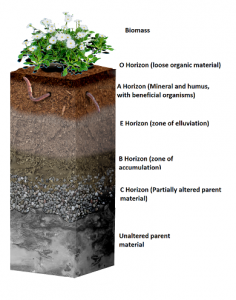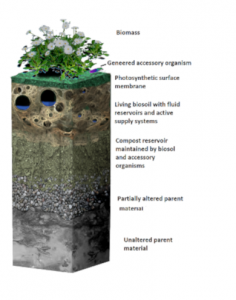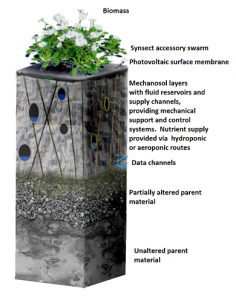BY LETTER
Artificial Soil
Technology > Application > Agriculture
Technology > Technology Type or Material > Drytech/Hylotech
Technology > Application > Everydaytech
Technology > Technology Levels > High Tech / Hitech
Technology > Technology Type or Material > Nanotech
Utility technology that is used in place of, or in combination with, soil.Technology > Technology Type or Material > Drytech/Hylotech
Technology > Application > Everydaytech
Technology > Technology Levels > High Tech / Hitech
Technology > Technology Type or Material > Nanotech
Artificial soils are used on colonised planets and in space habitats to support plant growth, either as part of a biosphere or other ecological life support system, or to grow crops of various kinds. Soils occur naturally on garden planets such as Earth, where they are formed by the action of specialised organisms and weathering on regolith. A garden planet such as Earth may support many thousands of distinct types of soil, but since access to the soils of Earth is severely restricted by the Goddess GAIA, almost all soils in the Terragen Sphere have been developed or acquired elsewhere.
Naturally occurring and moderately altered soils
 Image from Steve Bowers |
A range of soils that are often used for soil formation are un-modified or lightly modified xenosols, soil types that have their origin on alien garden worlds. The mulchsol of the planet Trees is very popular and widespread, both in tweaked and untweaked form; also widespread is xenopodsol obtained from the steppes of Elmo. However the micro-organisms in these xenosols are often incompatible with Terragen microbes, and may poison un-tweaked earthworms.
Biosols
 Image from Steve Bowers |
One widespread biosol type is a quasi-colonial organism, capable of growing many specialised accessory organisms from its large store of available genomes. In most cases these biosols adapt to and manage their local environment, retaining water and nutrients as necessary, and removing unnecessary, toxic or commercially valuable elements for collection or disposal. Biosols are often capable of a wide range of behaviours, and the the most sophisticated examples can be presapient, sapient or fully sophont.
Many biosols rely on mycorrhyza or an equivalent biological structure to supply water and nutrients straight to the roots; these are very thin, tube-like structures that penetrate the root and other tissue,generally as part of a symbiotic relationship with a specific plant.
Mechanosols and synanosols
 Image from Steve Bowers |
Most mechanosols are less massive than natural soils or biosols; this is because they use stronger materials to support the biomass, materials such as diamondoid or carborundumoid manufactured from minerals and atmospheric gases. They can also deliver water and nutients straight to the roots without having to rely on percolation to do the job.
Soils which are a hybrid between mechanosols and biosols are known as synanosols, since they rely on synanotechnology. These hybrid types are currently the most common type of soil in the Terragen Sphere. Sometimes a mechanosol may be the first stage in the development of a new biosphere, preparing the planetary surface for the later introduction of a biosol, synanosol or natural soil.
Sapientsols
Most modern soil types are autonomous or smart, able to regulate their own growth and adapt to changing environments. In many cases these structures will change their local environment to conform with certain goals. Many soil systems are at least presapient, and often have user-friendly personalities; vot-level soils are common-place. Less common are truly sophont soils, which are sometimes the sole sophont inhabitant (or inhabitants) of a respectably large space habitat- a few locations in the Terragen sphere are populated by sentient soils who grow plants and entire (non-sophont) biospheres upon themselves as a hobby. A few megastructures and other locations are hoist to transapient soil-based entities; most (but not all) are located in the Zoeific Biopolity, but a few are in the MPA, and some of these entities are sufficiently atypical that they have joined the Panvirtuality.Related Articles
Appears in Topics
Development Notes
Text by Steve Bowers
from an original short entry by John B
Initially published on 20 June 2003.
page uploaded 20 June 2003, last modified 2 January 2008
Original idea from the TransTech mailing lists, posted on the OA mail list Dec 2002 by Ben Higginbottom
from an original short entry by John B
Initially published on 20 June 2003.
page uploaded 20 June 2003, last modified 2 January 2008
Original idea from the TransTech mailing lists, posted on the OA mail list Dec 2002 by Ben Higginbottom






